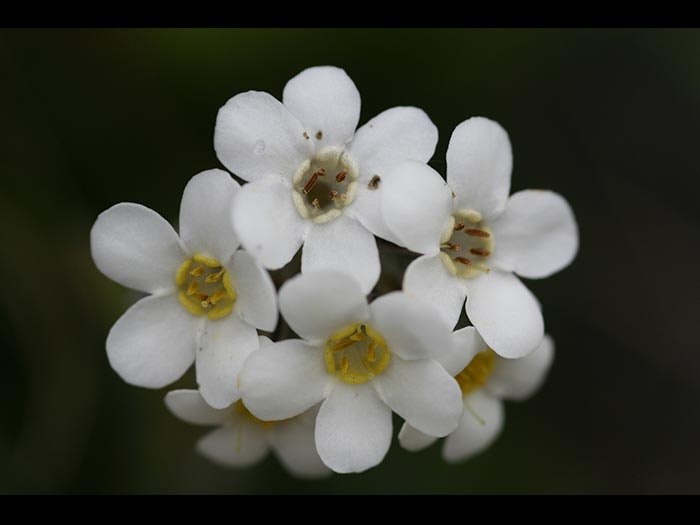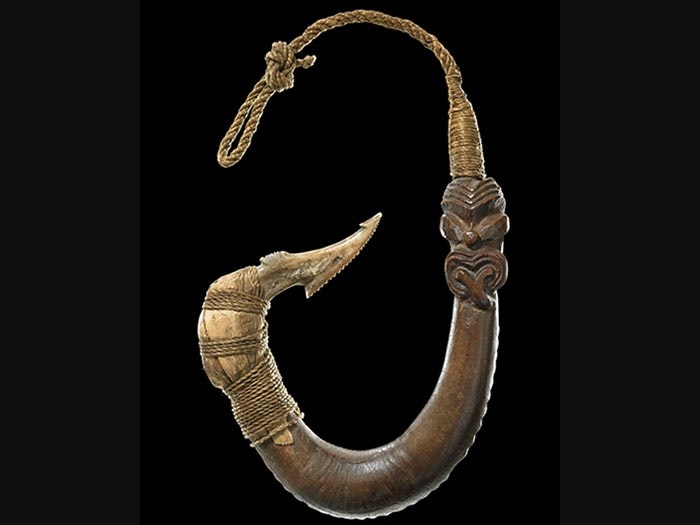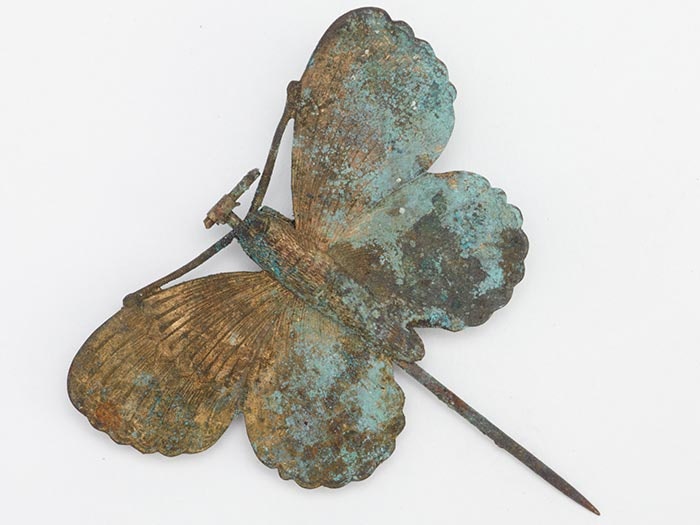
Tuhinga 23, 2012
Full Tuhinga issue 23 (4.86 MB)
Or download the individual article you’re interested in below.
The traditional Māori ‘internal-barb’ fishhook examines how these tools were used in the time before European arrival, taking clues from ancient karakia.
Go to The traditional Māori ‘internal-barb’ fishhook
A unique Māori fishhook: rediscovery of another Cook voyage artefact examines an outstanding example of ornate carving.
Go to A unique Māori fishhook: rediscovery of another Cook voyage artefact
Lectotypification of three species of forget-me-nots (Myosotis: Boraginaceae) from Australasia provides lectotypes for three species of forget-me-nots, with the rationale for each selection carefully explained and specimens illustrated in detail.
Go to Lectotypification of three species of forget-me-nots (Myosotis: Boraginaceae) from Australasia
A new species of soft tick (Ixodoidea: Argasidae) from the New Zealand lesser short-tailed bat, Mystacina tuberculata Gray describes and examines a new species of tick, including its association with the New Zealand lesser short-tailed bat, taxonomic history andaffinities with Australian bat-tick fauna.
Go to A new species of soft tick (Ixodoidea: Argasidae) from the New Zealand lesser short-tailed bat, Mystacina tuberculata Gray
Collecting kids’ stuff: in search of the history of childhood in New Zealand museums examine show childhood – an extremely elusive element of history – is recorded and presented through objects in New Zealand museums.
Go to Collecting kids’ stuff: in search of the history of childhood in New Zealand museums
Tuku: gifts for a king and the panoplies of Titore and Patuone examines the historical importance of gifts to Māori, looking at two mere pounamu (greenstone clubs) given by chiefs Titore and Patuone to King William IV and the sets of amour then given in return.
Go to Tuku: gifts for a king and the panoplies of Titore and Patuone
First World War posters at Te Papa examines Te Papa’s collection of colourful and dramatic First World War posted, with a focus on their changing function and meanings during the war years and in the years since.
Go to First World War posters at Te Papa
The traditional Māori ‘internal-barb’ fishhook
Chris D. Paulin
ABSTRACT: Pre-contact Māori used a variety of fishhook designs to target fish species in different habitats. Following the introduction of metal hooks by Europeans, many traditional fishing practices were abandoned and the mātauranga, or knowledge, surrounding the use of the different hooks was lost. However, mātauranga contained in ancient Māori karakia, or incantations, documented by early historians reveals clues to how some of the traditional hooks functioned.
The traditional Māori ‘internal-barb’ fishhook (1.03 MB)
A unique Māori fishhook: rediscovery of another Cook voyage artefact
Chris D. Paulin
ABSTRACT: Examination of Māori fishhooks known to have been collected during Captain Cook’s voyages of exploration (1768–79) suggests that ornately carved examples were extremely rare pre-European contact. One uniquely carved hook, held in the National Museum of Ireland, can be confirmed as a Cook voyage artefact through an illustration in an unpublished early nineteenth-century portfolio by Kenelm H. Digby, held in the New South Wales State Library, Sydney, Australia.
A unique Māori fishhook: rediscovery of another Cook voyage artefact (762.06 KB)
Lectotypification of three species of forget-me-nots (Myosotis: Boraginaceae) from Australasia
Carlos A. Lehnebach
ABSTRACT: Lectotypes for the names of one Australasian and two New Zealand native forget-me-nots are selected: Myosotis australis R.Br., M. forsteri Lehm. andM. goyenii Petrie, respectively. The collection of the type material of M. forsteri by J.R. and G. Forster at Dusky Bay (South Island, New Zealand), and not in Australia, is further supported. Images of all three lectotypes are included.
Lectotypification of three species of forget-me-nots (Myosotis: Boraginaceae) from Australasia (950.14 KB)
A new species of soft tick (Ixodoidea: Argasidae) from the New Zealand lesser short-tailed bat, Mystacina tuberculata Gray
Allen C.G. Heath
ABSTRACT: Carios quadridentatus, a new species of argasid tick associated with the New Zealand lesser short-tailed bat, is described and illustrated from larval material. This is the second species of soft tick found in New Zealand, bringing the total number of tick species breeding in New Zealand to 11. The taxonomic history of bat ticks is discussed, together with the affinities of the new species with the Australian bat-tick fauna.
A new species of soft tick (Ixodoidea: Argasidae) from the New Zealand lesser short-tailed bat, Mystacina tuberculata Gray (1.20 MB)
Collecting kids’ stuff: in search of the history of childhood in New Zealand museums
Lynette Townsend
ABSTRACT: This paper questions the extent to which museum collections capture the history of childhood. It advances the premise that collections are shaped by the historical context within which they were created, whether at the level of social discourse or the activities of individual people. This is evident in the types of childhood objects collected and in the changing way these objects are valued by the museum. In the museums examined here, the Museum of New Zealand Te Papa Tongarewa (Te Papa) and the Auckland War Memorial Museum (Auckland Museum), objects change from being valued as ethnographic specimens to colonial artefacts and high-end decorative art, to everyday objects that embody multiple perspectives and personal stories. Yet within these categories, the object-focused case studies in this paper show that the distinctive way in which museums make history enables children to become more visible. The paper argues that in collecting the material culture of childhood, museums capture a unique and extremely elusive element of history.
Collecting kids’ stuff: in search of the history of childhood in New Zealand museums (870.98 KB)
Tuku: gifts for a king and the panoplies of Titore and Patuone
Philip G. Parkinson
ABSTRACT: The customary practice of tuku, or gift exchange, by Mäori chiefs is exemplified in the formal gifts of two mere pounamu (greenstone clubs) by Titore and Patuone to King William IV of the United Kingdom in 1834, in the expectation of a formal return. The formal return was of two sets of plate armour, that for Titore arriving in 1835 and that for Patuone two years later, in 1837. The former is in the Museum of New Zealand Te Papa Tongarewa (Te Papa) but the latter is lost, although a receipt and a detailed description survive, along with good documentation. The two mere pounamu (as far as can be determined) have also been located and are illustrated for the first time; they are still in the Royal Collection, at St James’s Palace, London. ‘His Highness Titore’ was killed at the Bay of Islands in 1837, but a formal salute to him was fired from HMS Rattlesnakeon the orders of Captain William Hobson at that time. Patuone dined with Hobson on HMS Herald on 6 February 1840, presenting him with a further mere pounamu for Queen Victoria, as he had for her late uncle. This mere is one of two that were retained in Hobson’s family after his death in 1842, and is also in Te Papa, here illustrated. Patuone’s gifts to the Queen symbolically confirmed his cession of sovereignty to her.
Tuku: gifts for a king and the panoplies of Titore and Patuone (1.39 MB)
First World War posters at Te Papa
Stephanie Gibson
ABSTRACT: This paper examines a collection of international First World War posters held by the Museum of New Zealand Te Papa Tongarewa (Te Papa), in terms of its provenance, reception and display at the end of, and in the years immediately after, the First World War (1914–19). The paper details how and why the posters entered the Dominion Museum (now Te Papa) in 1918–19, their subsequent display from 1921 to 1924, and how they were received during this period.
The posters came to New Zealand as a result of transnational networks that existed in the British Empire. They were intended for the national collection and display in a hoped for national war museum because they could illustrate important aspects of the war. However, their function and meanings shifted as they moved from the streets to museums and exhibitions. They became markers of imperial effort and relationships, but also reminders of the emotions of the war years. The paper discusses reasons for this memorialising impulse and continuing engagement with war posters.
The colourful and dramatic international posters in the collecion are briefly compared to New Zealand’s comparatively plain letterpress printed posters. The lack of pictorial content in New Zealand’s posters, and the New Zealand government’s reliance on imported posters for recruitment purposes, has led to absences in the relevant literature, which this paper addresses.
First World War posters at Te Papa (1.94 MB)

